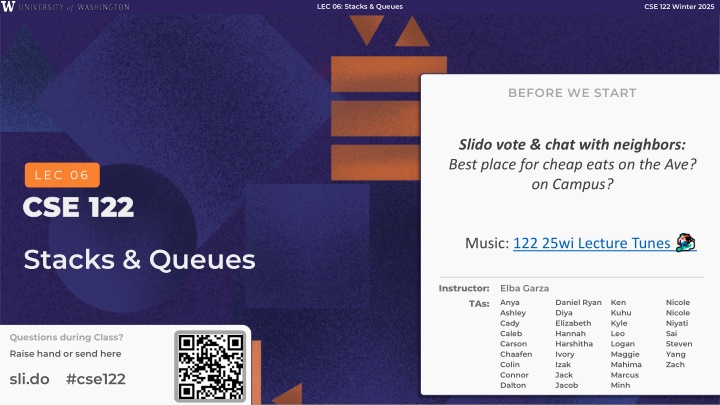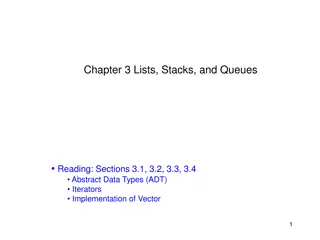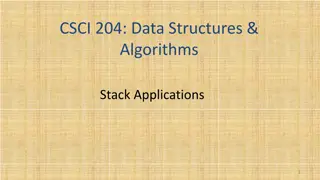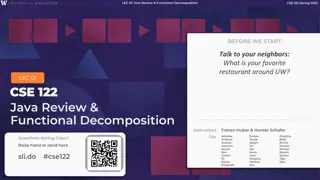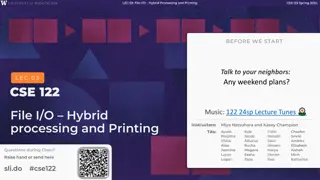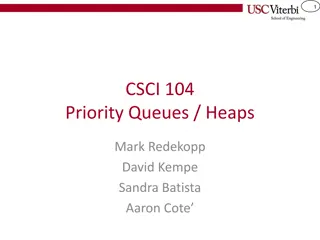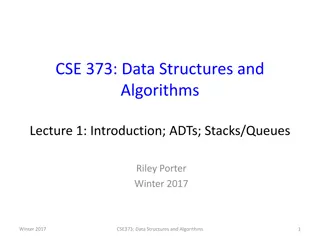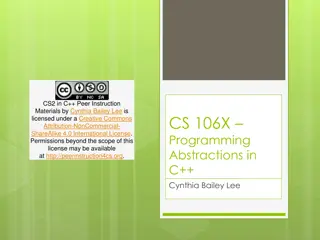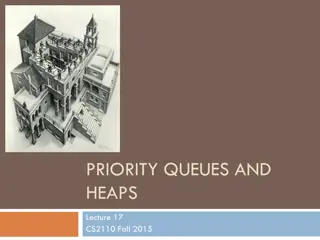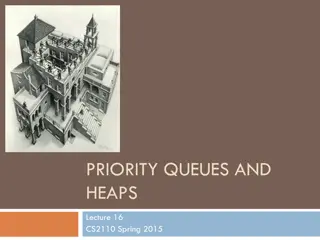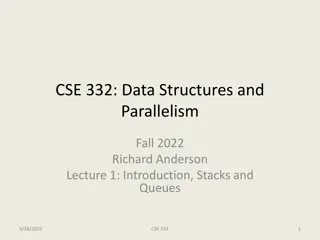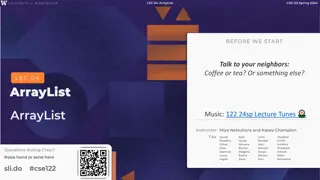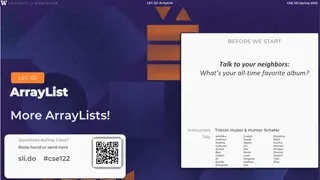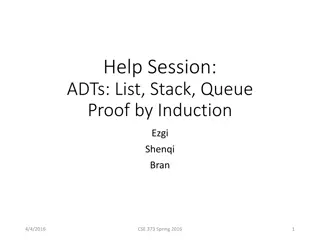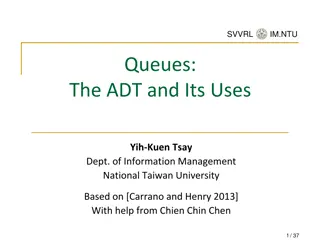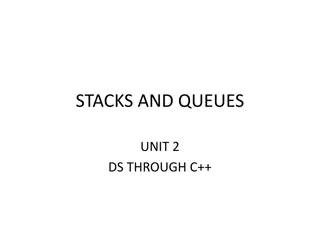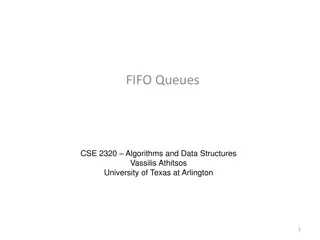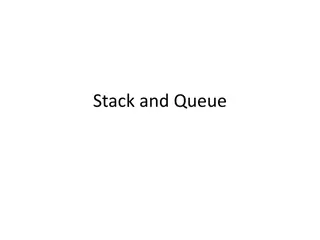Stacks & Queues in CSE 122 Winter 2025
This CSE 122 lecture covers the fundamentals of stacks and queues, including problem-solving techniques, data structures, manipulation, and optimizations. Announcements regarding quizzes, creative projects, and programming assignments are highlighted, along with the importance of feedback and metacognition for student success.
Download Presentation

Please find below an Image/Link to download the presentation.
The content on the website is provided AS IS for your information and personal use only. It may not be sold, licensed, or shared on other websites without obtaining consent from the author.If you encounter any issues during the download, it is possible that the publisher has removed the file from their server.
You are allowed to download the files provided on this website for personal or commercial use, subject to the condition that they are used lawfully. All files are the property of their respective owners.
The content on the website is provided AS IS for your information and personal use only. It may not be sold, licensed, or shared on other websites without obtaining consent from the author.
E N D
Presentation Transcript
LEC 06: Stacks & Queues CSE 122 Winter 2025 BEFORE WE START Slido vote & chat with neighbors: Best place for cheap eats on the Ave? on Campus? LEC 06 CSE 122 CSE 122 Music: 122 25wi Lecture Tunes Stacks & Queues Instructor: Elba Garza Anya Ashley Cady Caleb Carson Chaafen Colin Connor Dalton Daniel Ryan Diya Elizabeth Hannah Harshitha Ivory Izak Jack Jacob Ken Kuhu Kyle Leo Logan Maggie Mahima Marcus Minh Nicole Nicole Niyati Sai Steven Yang Zach TAs: Questions during Class? Raise hand or send here sli.do #cse122
LEC 06: Stacks & Queues CSE 122 Winter 2025 Lecture Outline Announcements Review: ADTs, Stacks & Queues Queue Manipulation Stack Manipulation - Problem Solving
LEC 06: Stacks & Queues CSE 122 Winter 2025 Announcements Quizzes - Quiz 0 was yesterday - Feedback releasing sometime before Quiz 1 (February 18th) - Metacognition: How did it go? Was your studying and preparation effective? Creative Project 1 is due tomorrow by 11:59pm PT Programming Assignment 1 releasing on Friday - Focus on Stacks & Queues - Due Thursday, February 6th by 11:59pm PT Resub 0 closed yesterday (Tuesday), but Resub 1 will open tomorrow! - C0, P0 eligible for R1 Viewing feedback in Ed - Having difficulty finding it? Don t know how to see your grade? Go to IPL or ask your section TA! This feedback is super important! Don t miss out on it!
LEC 06: Stacks & Queues CSE 122 Winter 2025 Lecture Outline Announcements Review: Stacks & Queues Queue Manipulation Stack Manipulation - Problem Solving
LEC 06: Stacks & Queues CSE 122 Winter 2025 (PCM) Stacks & Queues PCM focused on these new data structures! Some collections are constrained, only use optimized (but limited) operations - Stack: retrieves elements in reverse order as added - Queue: retrieves elements in same order as added Why optimize? Think dedicated tool instead of a Swiss Army knife pop, peek push front back remove, peek add top 3 2 1 1 2 3 bottom queue stack
LEC 06: Stacks & Queues CSE 122 Winter 2025 (PCM) Abstract Data Types Abstract Data Type (ADT): A specification of a collection of data and the operations that can be performed on it. - Describes what a collection does, not how it does it (not implementation!) - Think of it as an idea of a data type We don't know exactly how a stack or queue is implemented, and we don't need to! - Only need to understand high-level idea of what a collection does - Stack: retrieves elements in reverse order as added. - Queue: retrieves elements in same order as added.
LEC 06: Stacks & Queues CSE 122 Winter 2025 Wait, ADT? Interfaces? Abstract Data Type (ADT): A description of the idea of a data structure including what operations are available on it and how those operations should behave. For example, the English explanation of what a list should be. Interface: Java construct that lets programmers specify what methods a class should have. For example the List interface in java. Implementation: Concrete code that meets the specified interface. For example, the ArrayList and LinkedList classes that implement the List interface.
LEC 06: Stacks & Queues CSE 122 Winter 2025 (PCM) Stacks Stack: A collection based on the principle of adding elements and retrieving them in the opposite order. - Last-In, First-Out ("LIFO") - Elements are stored in order of insertion. - We do not think of them as having indexes. - Client can only add/remove/examine the last element added (the "top") top Basic Stack operations: push: Add an element to the top pop: Remove the top element peek: Examine the top element push pop bottom
LEC 06: Stacks & Queues CSE 122 Winter 2025 Stacks in Computer Science Programming languages and compilers: - method calls are placed onto a stack (call - compilers use stacks to evaluate expressions Operating Systems: - Call stacks memory stack for processes data Matching up related pairs of things: - find out whether a string is a palindrome - examine a file to see if its braces { } match - convert "infix" expressions to pre/postfix Sophisticated algorithms: - searching through a maze with "backtracking - many programs use an "undo stack" of previous operations push, return pop)
LEC 06: Stacks & Queues CSE 122 Winter 2025 (PCM) Programming with Stacks Stack<E>() push(value) places given value on top of stack pop() removes top value from stack and returns it; throws EmptyStackException if stack is empty peek() returns top value from stack without removing it; throws EmptyStackException if stack is empty size() returns number of elements in stack isEmpty() returns true if stack has no elements constructs a new stack with elements of type E "c" "b" "a" Stack<String> s = new Stack<String>(); s.push("a"); s.push("b"); s.push("c"); System.out.println(s.pop()); - Stack has other methods that we will ask you not to use
LEC 06: Stacks & Queues CSE 122 Winter 2025 (PCM) Queue Queue: Retrieves elements in the order they were added. - First-In, First-Out ("FIFO") - Elements are stored in order of insertion but don't have indexes. - Client can only add to the end of the queue, and can only examine/remove the front of the queue. Basic Queue operations: - add (enqueue): Add an element to the back. - remove (dequeue): Remove the front element. - peek: Examine the front element. remove front back add
LEC 06: Stacks & Queues CSE 122 Winter 2025 Queues in Computer Science Operating systems: - Queue of print jobs to send to the printer - Queue of programs / processes to be run - Queue of network data packets to send Computer Architecture - Miss status/handling register (MSHR) queue - Instruction fetch queue - Issue queue - Instruction pipeline in general! Programming: - Modeling a line of customers or clients - Storing a queue of computations to be performed in order Real world examples: - People on an escalator or waiting in a line - Cars at a gas station (or on an assembly line)
LEC 06: Stacks & Queues CSE 122 Winter 2025 (PCM) Programming with Queues add(value) remove() places given value at back of queue removes value from front of queue and returns it; throws a NoSuchElementException if queue is empty returns front value from queue without removing it; returns null if queue is empty returns number of elements in queue returns true if queue has no elements front back peek() 42 -3 17 size() isEmpty() Queue<Integer> q = new LinkedList<Integer>(); q.add(42); q.add(-3); q.add(17); System.out.println(q.remove()); IMPORTANT: When constructing a queue you must use a new LinkedList object instead of a new Queue object. (More on that with Interfaces.)
LEC 06: Stacks & Queues CSE 122 Winter 2025 Lecture Outline Announcements Review: Stacks & Queues Queue Manipulation Stack Manipulation - Problem Solving
LEC 06: Stacks & Queues CSE 122 Winter 2025 Lecture Outline Announcements Review: Stacks & Queues Queue Manipulation Stack Manipulation - Problem Solving
LEC 06: Stacks & Queues CSE 122 Winter 2025 Lecture Outline Announcements Review: Stacks & Queues Queue Manipulation Stack Manipulation - Problem Solving
LEC 06: Stacks & Queues CSE 122 Winter 2025 Problem Solving On their own, Stacks & Queues are quite simple with practice (few methods, simple model) Some of the problems we ask are complex becausethe tools you have to solve them are restrictive - sum(Stack) is hard with a Queue as the auxiliary structure We challenge you on purpose here to practice problem solving Source: Oleson, Ko (2016) - Programming, Problem Solving, and Self-Awareness: Effects of Explicit Guidance
LEC 06: Stacks & Queues CSE 122 Winter 2025 Common Problem-Solving Strategies Analogy Is this similar to a problem you ve seen? - sum(Stack) is probably a lot like sum(Queue), start there! Brainstorming Consider steps to solve problem before writing code - Try to do an example by hand outline steps Solve Sub-Problems Is there a smaller part of the problem to solve? - Move to queue first Debugging Does your solution behave correctly on the example input. - Test on input from specification - Test edge cases ( What if the Stack is empty? ) Iterative Development Can we start by solving a different problem that is easier? - Just looping over a queue and printing elements
LEC 06: Stacks & Queues CSE 122 Winter 2025 Common Stack & Queue Patterns Stack Queue and Queue Stack - We give you helper methods for this on problems Reverse a Stack with a S Q + Q S Cycling a queue: Inspect each element by repeatedly removing and adding to back size times - Careful: Watch your loop bounds when queue s size changes A splitting loop that moves some values to the Stack and others to the Queue
